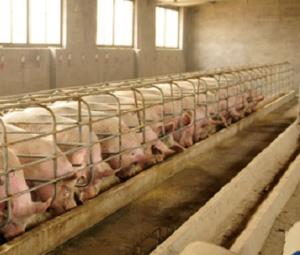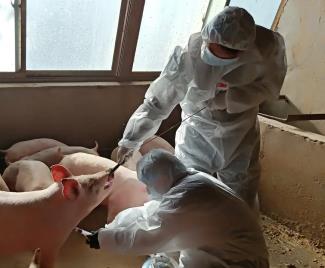 Cooperative Research conducted in the U.K. and China on emerging G4 EA H1N1 influenza in swine has demonstrated that the pathogen is unlikely to be transmitted between humans. Infection with the emerging swine strain of H1N1 influenza was confirmed from the presence of specific antibodies to the G4 EA virus in hog farmers and packing plant workers in China. Because the infection involved an H1N1 variant, scientists recognize a possible pandemic potential given that the 2009 “swine flu” outbreak and the 1918-1920 “Spanish flu” were both caused by H1N1 influenza virus. The H1N1 Influenza A virus responsible for the 2009 pandemic contained a unique combination of genes derived from both mammalian and avian species.
Cooperative Research conducted in the U.K. and China on emerging G4 EA H1N1 influenza in swine has demonstrated that the pathogen is unlikely to be transmitted between humans. Infection with the emerging swine strain of H1N1 influenza was confirmed from the presence of specific antibodies to the G4 EA virus in hog farmers and packing plant workers in China. Because the infection involved an H1N1 variant, scientists recognize a possible pandemic potential given that the 2009 “swine flu” outbreak and the 1918-1920 “Spanish flu” were both caused by H1N1 influenza virus. The H1N1 Influenza A virus responsible for the 2009 pandemic contained a unique combination of genes derived from both mammalian and avian species.
Studies have shown that the virus has circulated in hogs since 2016 without extensive infection of humans. Molecular biologists maintain that numerous mutations would have to occur for the virus to become widespread in human populations.
The reports of studies conducted in China and published in the Proceedings of the  National Academy of Sciences stress the need for surveillance and control measures for this variant. The level of biosecurity on commercial hog farms in China has been intensified following the emergence of African swine fever (ASF). Precautions to prevent the introduction of the highly pathogenic ASF will reduce the possibly of dissemination of the H1N1 variant.
National Academy of Sciences stress the need for surveillance and control measures for this variant. The level of biosecurity on commercial hog farms in China has been intensified following the emergence of African swine fever (ASF). Precautions to prevent the introduction of the highly pathogenic ASF will reduce the possibly of dissemination of the H1N1 variant.
Vaccination of hogs against H1N1 and incorporation of the variant into seasonal human influenza vaccines may be required should more extensive infection occur among those connected with the hog industry in China.